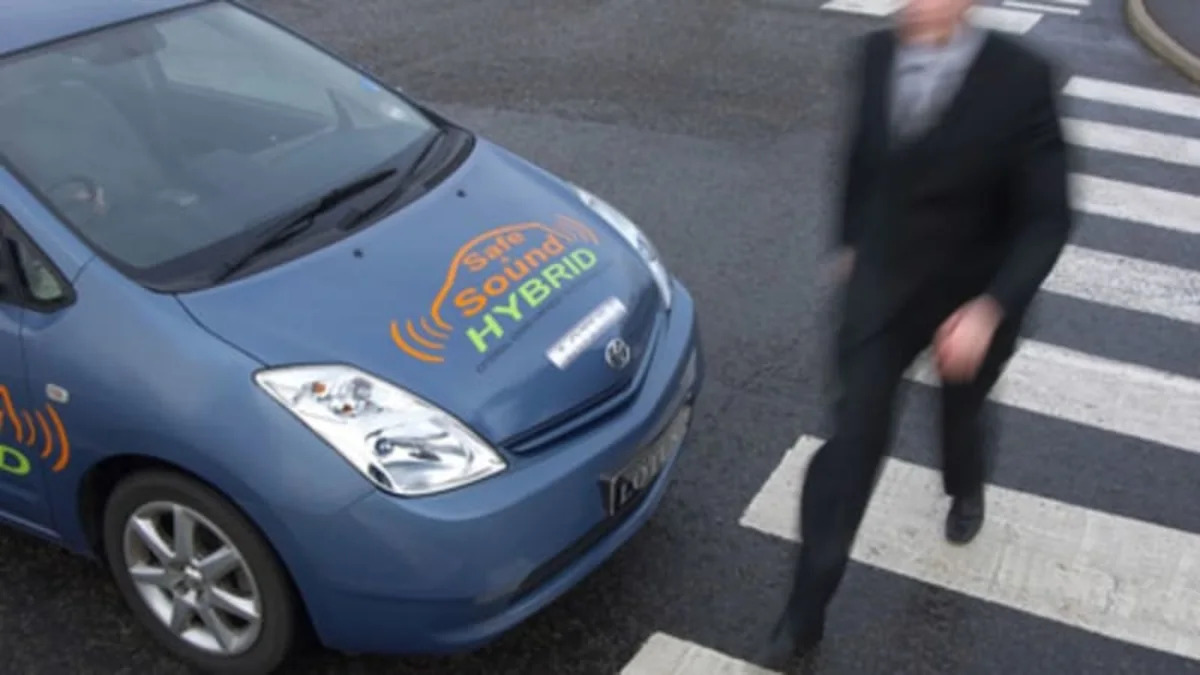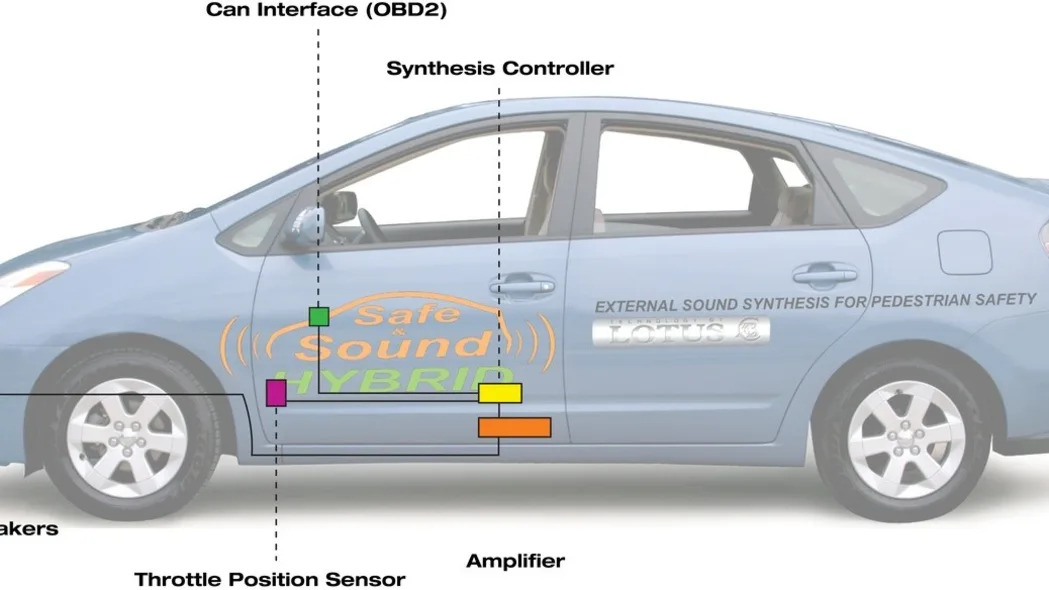Click above for gallery of Lotus' Safe and Sound Hybrid
Hybrid vehicles have the potential to save a few bucks at the pump, but advocates for the blind have continued to warn about their potential to harm to the seeing impaired. Lotus' automotive consultancy arm is trying to avert the risk of hybrids quietly running in electric mode with its "Safe and Sound" demo car.
This specially equipped Toyota Prius has been fitted a waterproof speaker mounted above the radiator that can emit a sound similar to a flat-six or V8, based off the vehicle's speed and throttle position. Once the internal combustion engine kicks in, the system is muted, allowing the 1.5-liter inline four to sing its siren song.
Hit the jump to read the press release and see a video of the "Safe and Sound" demo car in action. Also keep in mind that we've yet to run across a report of a blind person being hit by a hybrid car, though there was that one kid who got knocked off his bike.
Hybrid vehicles have the potential to save a few bucks at the pump, but advocates for the blind have continued to warn about their potential to harm to the seeing impaired. Lotus' automotive consultancy arm is trying to avert the risk of hybrids quietly running in electric mode with its "Safe and Sound" demo car.
This specially equipped Toyota Prius has been fitted a waterproof speaker mounted above the radiator that can emit a sound similar to a flat-six or V8, based off the vehicle's speed and throttle position. Once the internal combustion engine kicks in, the system is muted, allowing the 1.5-liter inline four to sing its siren song.
Hit the jump to read the press release and see a video of the "Safe and Sound" demo car in action. Also keep in mind that we've yet to run across a report of a blind person being hit by a hybrid car, though there was that one kid who got knocked off his bike.
The video meant to be presented here is no longer available. Sorry for the inconvenience.
PRESS RELEASE
Lotus Engineering, the world renowned automotive consultancy division of Lotus, has developed technologies to synthesise external sound on electric and hybrid vehicles to counteract the growing concern these 'quiet' vehicles pose to pedestrians and cyclists. A simulation of a real engine sound is used on the 'Safe & Sound' Hybrid technology demonstrator vehicle, making it instantly recognisable that the vehicle is in motion.
Electric and hybrid vehicles, a favourite choice of the environmentally conscientious have recently come in for criticism from blind and partially sighted people. Due to the almost silent operation of hybrid vehicles at slower speed when running on electric power, the independent travel of the blind and partially sighted may be put at risk as they cannot hear these quiet vehicles as they approach, making crossing a road or walking through a car park hazardous.
Mike Kimberley, Chief Executive Officer of Group Lotus plc said "The increased acceptance of greener vehicles such as hybrid and electric vehicles is to be encouraged; they have an important role in improving fuel economy and reducing emissions. Our advanced external sound synthesis technology increases pedestrian safety, while retaining the car's environmental benefits. We hope that legislators introduce minimum noise requirements for vehicles to encourage the adoption of technologies, such as ours, which will ultimately increase pedestrian safety."
Clive Wood, Transport Policy Officer at The Guide Dogs for the Blind Association said: "Blind and partially sighted people use the noise of oncoming traffic as a cue for when it is safe to cross a road – if a 'quiet' hybrid electric vehicle is approaching then they will no longer have this cue and are immediately put at risk.
Wood continues: "As the leading voice on transport and mobility issues in the visual impairment sector, Guide Dogs believes further research and development is needed to address the issues of identifying 'quiet vehicles' for blind and partially sighted people. The charity recognises the environmental benefits of these vehicles however more consideration needs to be given to the safety implications to visually impaired pedestrians."
The Lotus 'Safe & Sound' Hybrid technology demonstrator uses a standard Toyota Prius, one of the highest volume and most advanced hybrid vehicles to demonstrate the sound synthesis application and compensate for the lack of engine noise emitted by the vehicle when running on an electric motor. What has resulted is the same environmentally conscious hybrid vehicle, without the potential risk to pedestrians and cyclists.
Duncan Vernon, Road Safety Manager, at RoSPA (Royal Society for the Prevention of Accidents) said: "Road safety professionals teach children that they can improve their safety by listening for traffic, and the sound of an approaching vehicle is a warning that most pedestrians will use before making the decision to cross the road. New electric engines make vehicles much quieter, so we need to look at ways of ensuring the safety of pedestrians. We welcome innovative solutions which address this."
The solution that Lotus has devised is a novel reapplication and development of its Sound Synthesis technology. This is a part of the Lotus suite of patented active noise technologies which comprise three main systems, Active Road Noise Cancellation, Engine Order Cancellation and Sound Synthesis.
To synthesise the engine sound, a road speed signal is taken from the vehicle and a waterproof loudspeaker system is positioned adjacent to the radiator allowing the sound to emanate from the front of the vehicle. Once the vehicle has passed, the sound is not heard. When the car is operating on the electric motor only, throttle and speed dependent synthesised sound projects a realistic engine sound in front of the vehicle. The technology was designed around the behaviour of a conventional engine, using an existing engine sound which makes it instantly recognisable with the pitch and frequency helping to identify vehicle distance and speed. If the hybrid's engine starts operating, at higher speeds or throttle demands or lower battery levels, the control system automatically stops the external synthesis. When the powertrain control system switches the car back to running on the electric motor only, the synthesis controller instantaneously sets the system running again. It is all completely automatic and the driver hears almost none of the additional sound.
In order to generate the engine sound, recordings of a suitable donor engine were made and analysed to establish the characteristic frequencies at different engine speeds. These frequencies are then entered into the synthesis controller in the form of a 'voice' which outputs the sound through an amplifier and out through the loudspeakers.
NOTES
An accompanying video new release can be viewed on the Lotus website http://www.grouplotus.com/engineering/downloads/videos.html.Please contact the Lotus PR Department if you require the film in web or broadcast version. High-resolution pictures of the Lotus Safe & Sound technology demonstrator can be downloaded from the media centre of the official Group Lotus website at http://www.grouplotus.com/mediacentre. The image library is for registered users only. Members of the press may register for the media centre.
About Lotus Active Noise Technologies
The Lotus suite of patented active noise cancellation technologies comprises three main systems, each of which can be used individually or in combination.
The first two systems are Active Road Noise Cancellation (ARNC) and Engine Order Cancellation (EOC). Both of these look to reduce noise levels in the cabin, particularly at frequencies that are audibly unpleasant. In the case of road noise, the system reduces broadband noise levels at frequencies below 250Hz whereas EOC tackles harmonic frequencies generated by ignition events in the engine.
Input signals from the engine (for EOC) or sensors mounted to the suspension system (for ARNC) are fed into the electronic controller, as are sound signals, measured by microphones located in the cabin. The software algorithms of the controller then calculate what sound is needed to provide cancellation and the speakers of the in-car entertainment system are used to put this into the cabin. All this takes just a few hundredths of a second and repeats and adapts constantly through the complex control system, seamlessly and instantaneously adapting to changes in speed or road condition. The cancellation system operates on the input signals so other noise in the vehicle such as the audio system and speech are not interfered with or cancelled. The result is a quieter, more pleasant cabin.
The third system is sound synthesis, the purpose of which is to enhance the sound in the cabin. The control system uses engine speed signal, a throttle position sensor and the in-car entertainment system to add sound. In this way a car could be made to sound sportier or be given the pleasing sound characters of, say, a flat 6 or V8 engine. Coupled with EOC and ARNC, the interior sound in the cabin can be tuned to enhance the driving experience and match the brand attributes of the vehicle.



Sign in to post
Please sign in to leave a comment.
Continue